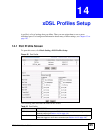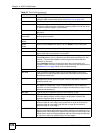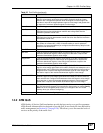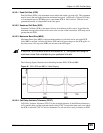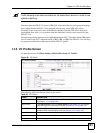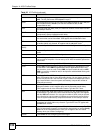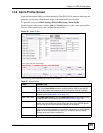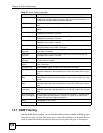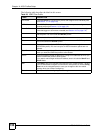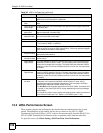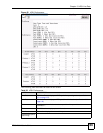
Chapter 14 xDSL Profiles Setup
IES-612-51A User’s Guide
132
AAL This field displays the ATM adaptation layer used by the VC profile.
aal5 - The VC profile uses ATM adaptation layer 5.
Class This field displays the type of ATM traffic class: cbr (constant bit rate), vbr (real-
time variable bit rate), nrt-vbr (non-real time variable bit rate) or ubr
(unspecified bit rate).
PCR This is the Peak Cell Rate (PCR), the maximum number of cells that the sender
can send per second.
CDVT This field displays the accepted tolerance of the difference between a cell’s
transfer delay and the expected transfer delay.
SCR The Sustained Cell Rate (SCR) sets the average cell rate (long-term) in cells
per second that can be transmitted. SCR applies with the vbr traffic class.
BT Burst Tolerance (BT) is the maximum number of cells that the port is guaranteed
to handle without any discards. BT applies with the vbr traffic class.
Select
Modify
Select a VC profile’s Select radio button and click Modify to edit the VC profile
Delete Select a VC profile’s Select radio button and click Delete to remove the VC
profile
The rest of the screen is for PVC configuration.
Name When editing a profile, this is the name of this profile. When adding a profile,
type a name for the profile. You can use up to 31 ASCII characters; spaces are
not allowed.
Encap Select the encapsulation type (LLC or VC) for this port.
Class Select CBR (constant bit rate) to specify fixed (always-on) bandwidth for voice
or data traffic. Select UBR (unspecified bit rate) for applications that are non-
time sensitive, such as e-mail. Select VBR (real time variable bit rate) or NRT-
VBR (non real time variable bit rate) for bursty traffic and bandwidth sharing with
other applications.
PCR The Peak Cell Rate (PCR) is the maximum rate at which the sender can send
cells. PCR applies with all of the ATM traffic classes. You can type a number of
(ATM) cells per second in the first field or type a number of kilobytes per second
in the second field to have the system automatically compute the number of
ATM cells per second.
CDVT Cell Delay Variation Tolerance (CDVT) is the accepted tolerance of the
difference between a cell’s transfer delay and the expected transfer delay.
CDVT applies with all of the ATM traffic classes. Type the CDVT here.
SCR The Sustained Cell Rate (SCR) sets the average cell rate (long-term) that can
be transmitted. Type the SCR, which must be less than the PCR. SCR applies
with the VBR traffic classes. You can type a number of (ATM) cells per second
in the first field or type a number of kilobytes per second in the second field to
have the system automatically compute the number of ATM cells per second.
BT Burst Tolerance (BT) sets a maximum number of cells that the port is
guaranteed to handle without any discards. Type the BT here. BT applies with
the VBR traffic classes.
Add Click Add to save your changes to the IES-612-51A’s volatile memory. The IES-
612-51A loses these changes if it is turned off or loses power, so use the Config
Save link on the navigation panel to save your changes to the non-volatile
memory when you are done configuring.
Cancel Click Cancel to start configuring the screen again.
Table 26 VC Profile (continued)
LABEL DESCRIPTION




